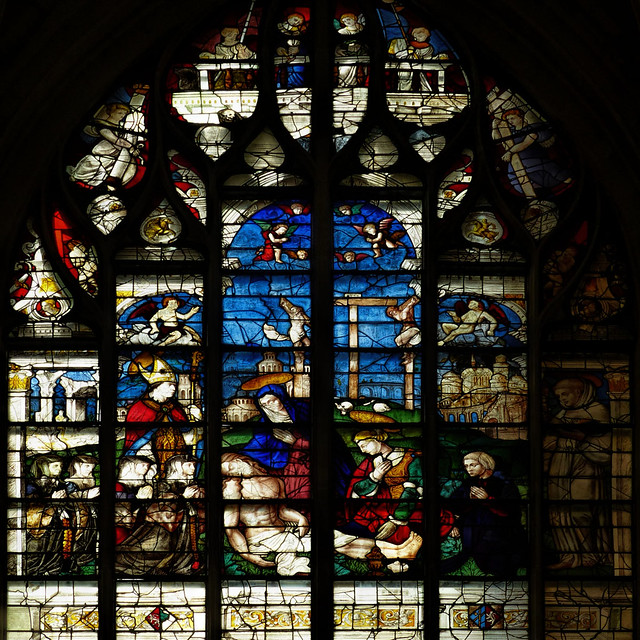Pieta by Bertin Duval - Alençon France

Renaissance-era stained glass window, created by the master glass painter Bertin Duval in 1530 and installed in the choir of Notre-Dame Church in Alençon (Orne, Normandy), exemplifies the transition from late Gothic to early Renaissance styles in French religious art. Measuring approximately 4 meters in height within a lancet-shaped frame, it employs pot-metal glass in rich jewel tones—deep blues, vivid reds, emerald greens, and golden yellows—fired with silver stain for luminous halos and flesh tones. The composition is vertically divided into three registers, framed by Gothic tracery with cusped arches and floral motifs, allowing diffused light to animate the narrative of Christ's Passion and Resurrection, evoking profound sorrow and hope.
Dominating the top lancet, a dramatic Crucifixion unfolds against a cobalt blue sky pierced by golden rays. Christ is affixed to a monumental tau cross at center, his elongated body pale and bloodied, flanked by the sorrowful Virgin Mary in flowing blue robes (left) and Saint John the Evangelist in red tunic (right), their gestures of lamentation rendered with expressive linearity. Thieves on smaller crosses hang to the sides, while Roman soldiers in segmented armor and a mounted centurion on horseback (right) witness the event; ladders and tools lie scattered below. Cherubim and seraphim hover in the spandrels, their white-robed forms edged in silver stain, symbolizing divine mourning. This scene, set amid stylized clouds and a distant Jerusalem skyline, captures the raw agony of Golgotha with Duval's characteristic attention to emotional depth and architectural detail.
The central register contains the heart of the window depicting the Lamentation over the Dead Christ in a verdant meadow evoking the Garden Tomb, blending tenderness with Renaissance humanism. The Virgin Mary, veiled in deep blue and gold-embroidered mantle, cradles her son's nude, lifeless body across her lap in a classic Pietà pose—her face etched with quiet devastation, one hand supporting his torso while the other touches his wound. Christ reclines limply, his head lolling back with closed eyes and thorny crown askew, wounds vivid in red enamel. Saint John the Evangelist, kneeling in green and red robes, head bowed in grief The group is composed in a semi-circle around a rocky sarcophagus, with symbolic elements like a lamb (Agnus Dei) and lilies for purity scattered in the grassy foreground. This intimate, pyramidal arrangement draws the viewer into the pathos, with subtle shading via painted grisaille enhancing three-dimensionality.
Duval’s balanced palette and narrative progression mirror the Passion’s journey from suffering to salvation, with light cascading downward. Influenced by Flemish humanism (e.g., Rogier van der Weyden), the elongated, expressive figures humanize the divine, while Gothic inscriptions (e.g., John 19) tie it to liturgy. The reinterpreted donors and bishop underscore the window’s role as a communal offering, with the blue-robed figure behind Saint John enriching the apostolic witness. Restored in the 19th century, it remains a luminous testament to Norman devotion amid pre-Reformation tensions.
